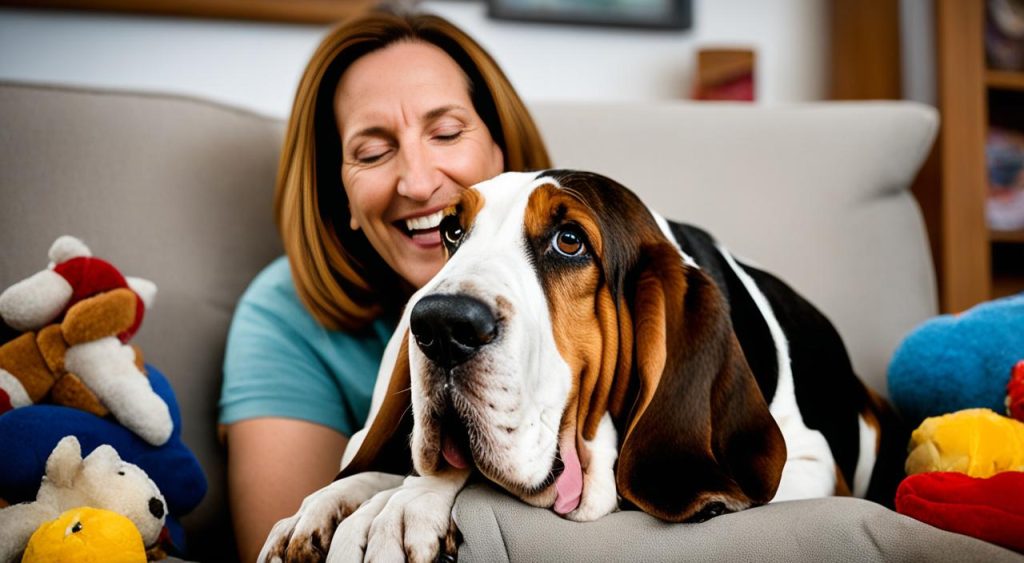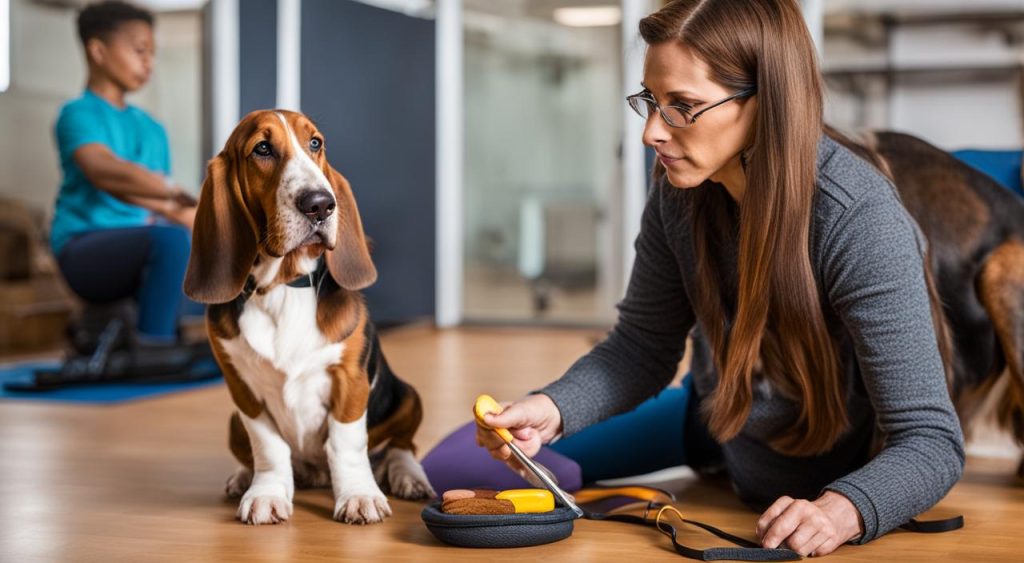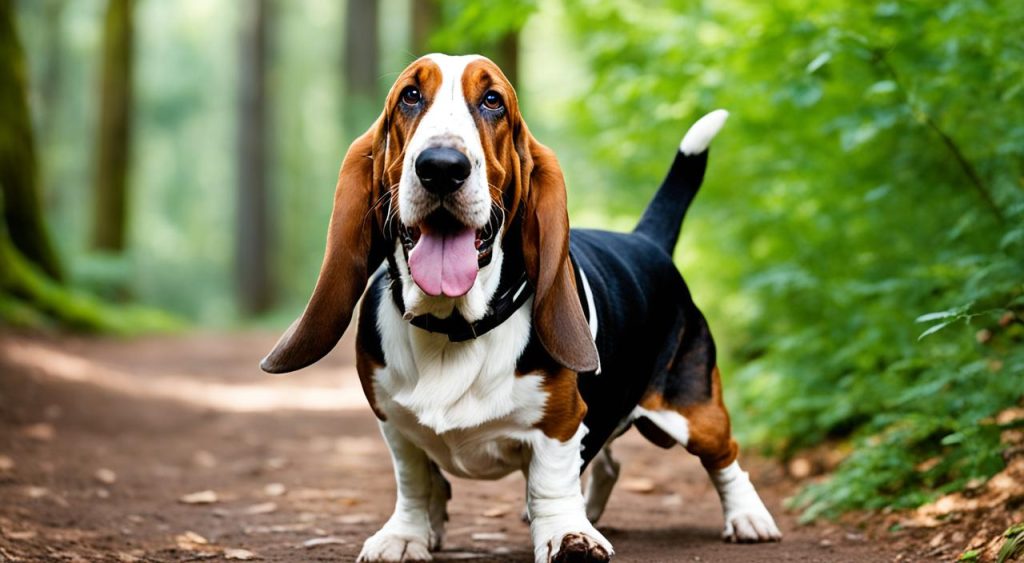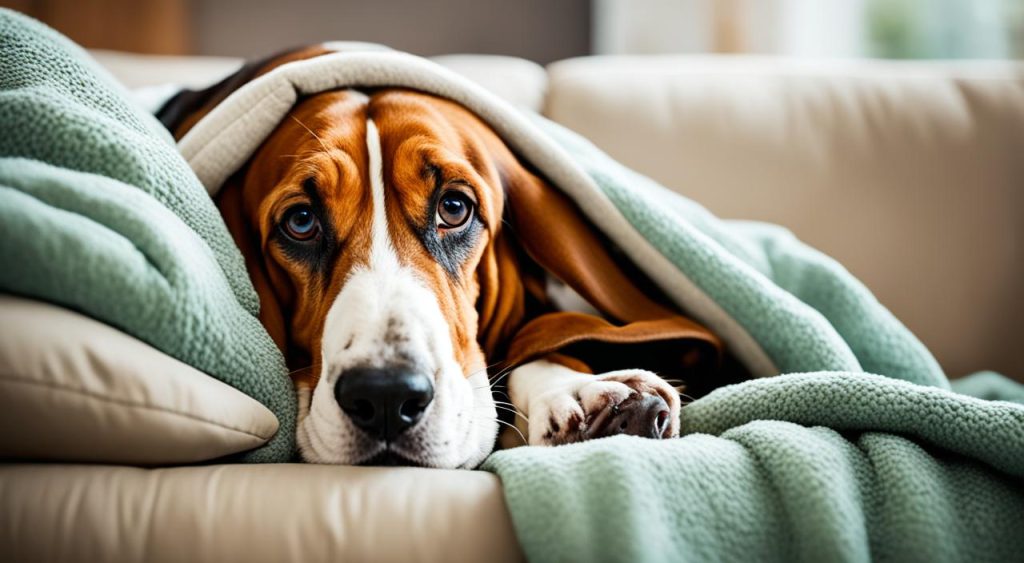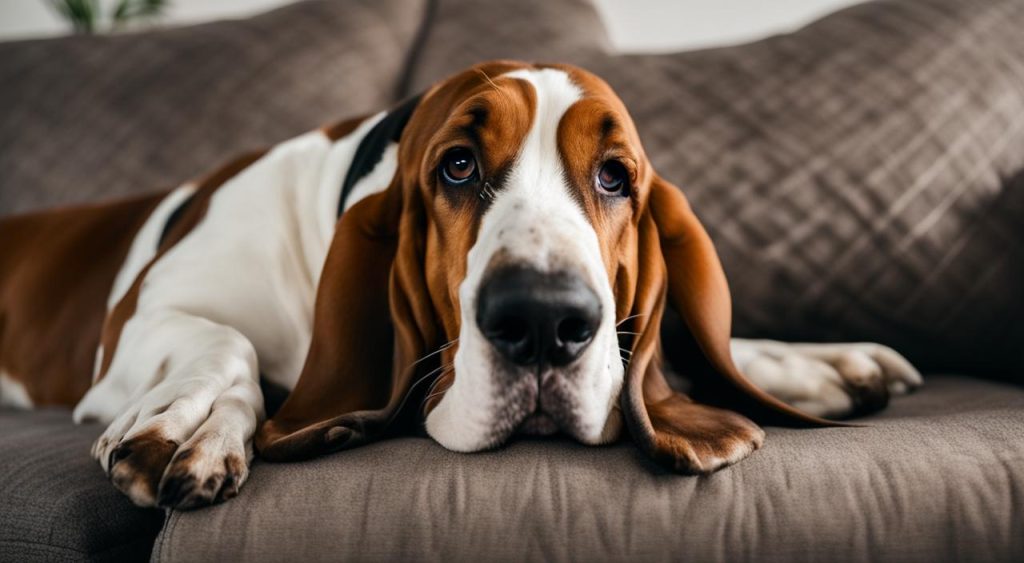Do you find yourself wondering why your Basset Hound insists on sitting on you? You’re not alone. Many Basset Hound owners are curious about this behavior and what it means. In this article, we’ll explore the reasons behind your Basset Hound’s sitting habits and shed light on their behavior.
Key Takeaways:
- Basset Hounds may sit on their owners as a sign of affection and to strengthen the bond between them.
- Sitting on the owner can also be a learned behavior that is reinforced through positive reinforcement.
- Some Basset Hounds sit on their owners to initiate playtime and engage in fun activities.
- They may also sit on you to communicate their ownership and mark their territory.
- Understanding these reasons can help you train your Basset Hound and establish boundaries.
Affection and Bonding
Basset Hounds have a unique way of showing their affection and strengthening their bond with their owners. One common behavior they exhibit is sitting on their owners. This behavior is their way of seeking physical contact and closeness, which they find comforting and reassuring.
When a Basset Hound sits on your lap or cozy up against you, it’s their way of expressing their love and trust. They seek the warmth of your presence and enjoy the feeling of being close to you. This behavior is not limited to Basset Hounds; other small breeds like Chihuahuas and larger breeds like Golden Retrievers also exhibit this behavior.
The close proximity and physical contact that occurs when a Basset Hound sits on their owner helps to strengthen the bond between the dog and their human. It creates a sense of intimacy and connection, similar to how pack members in the wild bond with each other. This behavior is their way of saying, “You are part of my family, and I feel safe and secure with you.”
Understanding and appreciating this cuddling behavior can deepen the bond between you and your Basset Hound. It is important to cherish these moments and reciprocate their affection by providing them with love, attention, and care.
Learned Behavior and Positive Reinforcement
When it comes to Basset Hound training, it’s important to understand that sitting on their owners can be a learned behavior that is reinforced through positive reinforcement.
When a Basset Hound sits on its owner and receives attention or affection, it associates the behavior with positive outcomes and is more likely to continue doing it. This behavior can be reinforced unintentionally, as owners may unknowingly reward their Basset Hound’s behavior with affection or treats.
Proper training and socialization play a crucial role in addressing any unwanted dominant behaviors or aggression that may arise from sitting on their owners. Consistent training techniques such as reward-based training and positive reinforcement can help redirect the Basset Hound’s behavior to more appropriate actions.
It’s important to establish boundaries and discourage any unwanted behaviors that may be associated with sitting on their owners. Basset Hounds should learn to respect personal space and understand that they can receive attention and affection through other positive behaviors.
Additionally, socialization with other animals and proper exposure to different environments can prevent dominance-related issues and aggressive behaviors towards other animals. By providing a well-rounded training and socialization program, Basset Hound owners can ensure their pets are well-behaved and have a positive relationship with their furry friends.
Playfulness and Initiation of Playtime
Some Basset Hounds have a unique way of initiating playtime – they sit on their owners! This behavior is their way of expressing their desire for interaction and fun. When your Basset Hound sits on you, it may nuzzle, lick, or even exhibit playful bows to get your attention and signal that it’s time to play.
Recognizing your Basset Hound’s body language cues is key to understanding when they want to engage in play. When you’re on the floor or ground, your Basset Hound may interpret that as an invitation to join in on the fun. So, the next time your furry friend sits on you and gives you those playful looks, it’s time to get involved and provide them with the outlets they need to release their energy.
Communication and Territory Marking
Basset Hounds have a unique way of communicating their ownership and marking their territory – by sitting on their owners. This behavior is a result of the scent glands in their body, which allow them to leave their scent on their owners as a way of signaling to other animals that they belong to them.
When other animals are present, such as other dogs or cats, Basset Hounds may exhibit this behavior more prominently as a way to assert their dominance. Sitting on their owners in the presence of other animals is a clear indication that the Basset Hound is staking its claim and marking its territory.
It is important, however, to discourage any aggressive or possessive behaviors that may arise from this territorial marking. While it’s natural for Basset Hounds to assert their dominance, it’s essential to establish appropriate boundaries and ensure that the behavior remains non-threatening.
Conclusion
In conclusion, Basset Hounds may sit on their owners for various reasons, including affection, learned behavior, initiation of playtime, communication, and territorial marking. Understanding these behaviors and their underlying motivations can help owners better care for and train their Basset Hounds. By providing the right training, positive reinforcement, and setting boundaries, owners can develop a strong bond with their Basset Hound while ensuring a harmonious relationship.
Conclusion
Sitting on their owners is a common behavior among Basset Hounds. It can be a sign of affection, a learned behavior, or a way to initiate playtime. Understanding the reasons behind this behavior can help owners provide the appropriate training and socialization to ensure a harmonious relationship with their Basset Hound.
It is important to establish boundaries and discourage any unwanted behaviors while still nurturing the bond between owner and dog. Regular training and positive reinforcement are essential in shaping their sitting habits and overall behavior. By consistently reinforcing desired behaviors and redirecting them from unwanted ones, Basset Hound owners can create a well-behaved and obedient pet.
In addition to training, proper care is also crucial for a happy Basset Hound. Regular grooming, including cleaning the ears and eyes, helps maintain their health and hygiene. By taking care of their physical well-being, owners can contribute to a comfortable and content Basset Hound.

